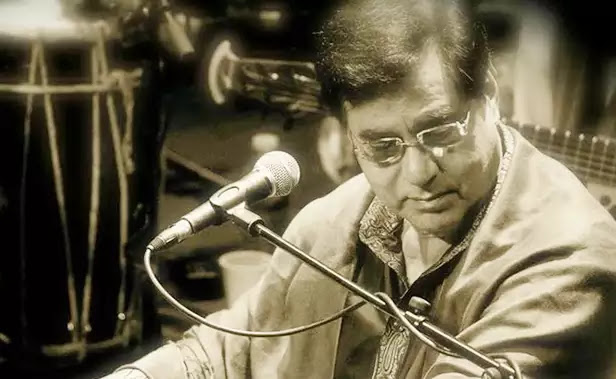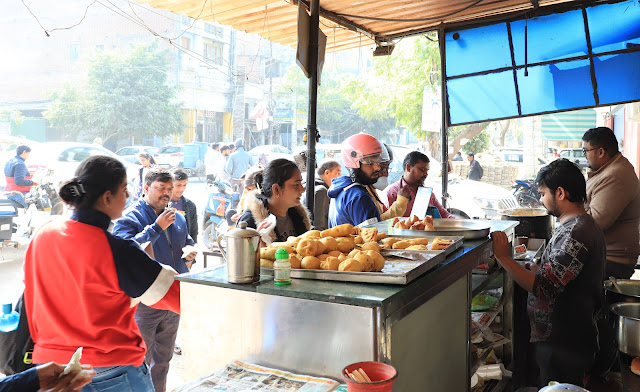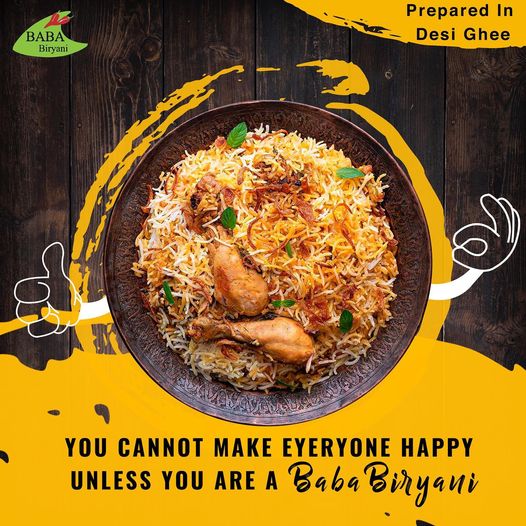Though many singers have tried their
hands on Tum Itna Jo Muskura Rahe Ho, a song from the 1982 Shabana Azmi film,
Arth, nothing touches your heart the way the original track does. Jagjit
Singh's buttery voice makes “Tum Itna Jo
Muskura Rahe Ho” a timeless classic.
Jagjit Singh and Chitra Singh. Two names. One identity. What truly has made them ‘unforgettable’ was the fact that their performances were not merely about sharab, shabab and shama and Parwana. They spoke of love, longing, dreams and dejection, hope and spirituality.
The pair
grew iconic through the ’70s and ’80s, triggering a trend of ‘couple singers’
but remained peerless till Chitra turned silent one day... After losing their
only son Vivek Singh (18) in a road accident, Chitra ‘lost her voice’ in 1990
and receded in the shadows.
The ghazal maestro, Jagjit Singh created a
rage amongst the music lovers decades ago, but still continues to be synonymous
with ghazals even for the younger generations.
There cannot be a single heartbeat that
hasn’t been touched with the soulful voice of Jagjit ji. Later he got married
to the ‘Queen of Ghazals’, Chitra Singh and they together democratized this
musical form and created some incredible music together.
Jagjit
Singh and Chitra Singh together earned the name of the ‘King and Queen of
Ghazals’. While everyone has their soulful hit tracks on their playlist, let us
take you to their love journey.
Jagjit Singh began his professional career
in 1961 by undertaking singing and composing assignments at All India Radio's
(AIR) Jallandhar station.
Not from a well-off family, as a child
Jagjit Singh used to study by the light of lanterns, due to lack of electricity
in the house. In an interview, Singh had stated that they even lacked the
facility of running water.
His father, Sardar Amar Singh Dhiman, who was a government employee, had hoped that Jagjit would become an engineer.
Jagjit Singh met the love of
his life, Chitra Singh in a studio to record a jingle for an advertisement.
When Jagjit Singh had fallen madly in love with a married lady, the husband had
asked for his wife’s hand.
The love story of Jagjit Singh and his wife
Chitra has been very filmy. In fact, Jagjit Singh had fallen madly in love with
Chitra, had reached near her husband to ask for his wife’s hand.
Bengali singer Chitra Shome married Debo Prasad Dutta, an executive in a leading advertising agency in the mid-50s. They had a daughter, Monica, in 1959.
The Velvet
Voice, Jagjit Met Ghazal Queen Chitra: For the first time in the year 1967.
Both Jagjit and Chitra met for the first
time in the year 1967. Jagjit Singh met his life Chitra in a studio. Chitra had
come to the studio to record the jingle of an ad.
Tumko Dekha Toh Yeh Khayaal Aaya,
Zindagi Dhoop, Tum Ghana
Saaya…
A music director wanted to mix the voices of
many singers and I was associated with Jagjit ji. When I met him for the first
time, he was resting in the room.
Chitra had further said that after hearing
his voice, I told the music director that his voice is very heavy. I can’t sing
a song with him. However, Chitra later agreed to sing the song with Jagjit
Singh.
The chemistry of Jagjit Singh and Chitra was
very popular in the 70-80s. After the divorce from Chitra’s first husband Debo
Prasad Dutta, Jagjit supported her a lot in this difficult time.
Jagjit Singh and Chitra Singh’s chemistry
worked like magic and there was no looking back for the much-in-love couple.
Jagjit and Chitra decided on forever in 1969 and it was the latter’s second
marriage.
Chitra says calling
him a ‘ghazal singer’ would be restricting Jagjit’s genius. “He was a unique
musician. He came to Mumbai (1965) with the same aspirations as anyone else.
But his voice was so different it never could match any hero.
It
only grew richer with time. When Mahesh Bhatt used his voice for Raj Kiran in
Arth (1983), he was a lot younger and his voice was not so heavy. We also sang
for Saath Saath (1982) where his voice suited the mood of the film.
But generally, his remained background
songs.” She underlines Jagjit’s role in popularizing the ghazal. “Earlier the
ghazal was referred to something sung for the elderly and those sung by Begum
Akhtar, Angoori Bai and others.
Chitra ji was earlier married
to Debo Prasad Dutta and had a daughter with him, Monica. Chitra ji decided to
part ways with her former partner in 1968 and moved on to live separately with
her daughter.
In this difficult phase, Jagjit ji lend his
support to Chitra ji and her daughter, Monica. But when he expressed his
feelings to her, Chitra didn’t say ‘yes’. And Jagjit was so much in love with
Chitra that he went on to ask her hand from her ex-husband, and said:" I
want to marry your wife."
I
want to marry your wife
Chitra had said that this time was very
difficult for her. But Jagjit Singh supported him a lot. After some time Jagjit
Singh also expressed his feelings in front of Chitra. But Chitra did not agree
to the marriage.
Chitra had further told that when I did not
say yes to him, he went to my ex-husband Debo and said that I want to marry
your wife. After which Jagjit Singh and Chitra got married in 1969 and were
together forever.
In 1982, their ghazals for films Arth and
Saath Saath lent the necessary gravitas to the offbeat films. In fact, the
combo album of Arth and Saath Saath was the highest-selling cassette that year.
The
first tragedy- Their son's death in 1990
It was a usual July evening. Jagjit was
watching a film on video with wife Chitra, when news of their son’s accident
tore their world apart.
Reportedly, Vivek’s car rammed into a BEST
truck, which was repairing streetlights late at night on July 27, 1990. Shocked
by the inconceivable trauma, Chitra lost her voice and withdrew into a shell.
“My
world came crashing down (after Vivek's demise). I reduced to 43 kilos and
looked like a ghost. I couldn’t face people — mera gala apne aap bandh ho gaya.
It stayed like that for nearly 14 years,” Chitra recalled in a rare interview”.
Gradually, Jagjit immersed himself in music
but memories of his son pervaded his life and art. “My son is my stage
partner,” he’d often say.
At a musical night organized by the Rajiv
Gandhi Foundation, Jagjit reportedly said, “Rajiv Gandhi and my son shared the
same birthday. Both died a violent death.” When he sang the ghazal Dard se mera
daaman bhar de, many in the audience were left teary-eyed.
Chitra did try to return to singing but the
emotional ordeal had dented her confidence as well. “One morning, while I was
looking at Vivek’s photograph, I felt I was dishonoring my gift. Vivek was so
proud of our singing. To honor his memory, I wanted to sing again.”
But, like an instrument not used for years’,
Chitra’s voice had lost its edge. “It’s the biggest tragedy that I cannot sing.
One day I’m doing well, the other day I’m back to square one. If I cannot match
my calibre, I’ll let myself down,” she shared her reservations.
The
Second Tragedy: Her daughter Monica committed suicide
Around
two decades later, Chitra’s world was upturned once again when her daughter
from her first marriage, ex-model Monica Dutta, committed suicide on May 29,
2009. She was 50. Monica married cinematographer Jehangir Choudhary in 1988.
The couple had two sons, Armaan and Umair.
In
2005, she divorced him and married British national, Mark Houghton Roger
Atkins, managing director of a firm in Mumbai. In 2007, she had filed a case of
harassment against Atkins. A non-bailable was issued warrant against Atkins in
2008, who had already left the country.
Jagjit was touring America when Monica
passed away. Devastated by the news, he cancelled all his performances and
returned home. “Papa (Chitra’s endearment for Jagjit) was shaken after Monica’s
death. She was like a daughter,” shared Chitra.
“My daughter was so beautiful and strong.
But ultimately, she lost. She couldn’t cope any more. She had a rough life,”
confided Chitra. “I was talking to her till 3 am. I must have been insensitive
not to have sensed that she’d do such thing.
What kind of a mother am I? I should have
given her more support…. I blame myself for that,” shared a wrecked Chitra.
Final
Tragedy: Death of a soulmate-- jagjit passed away in 2011
Two years later, in 2011, a series of 70
musical events were planned worldwide to celebrate Jagjit’s 70th birthday. One
such was a show with Ghulam Ali in Mumbai. Just prior to that, Jagjit, on 23
September 2011, suffered brain hemorrhage. He passed away on 10 October.
“When I lost Baboo (Vivek) the question ‘why
me’ would bother me. But spirituality changes your thinking. There has to be a
reason for all this,” she said at the passing away of Jagjit.
That
chapter of her life had been silenced forever.
It
was great news for her fans in 2017, when after 27 years of staying away from
music; Chitra was slated to sing at the venerated Sankatmochan Sangeet Samaroh
on the premises of the Sankatmochan temple in Kashi. But an emotional Chitra
broke down on stage and lamented her inability to perform…
But for her fans, her ghazals remains a
cherished treasure. From gramophone records, cassettes and CDs to digital music
platforms… they have a life beyond time.
But for her fans, her ghazals remains a
cherished treasure. From gramophone records, cassettes and CDs to digital music
platforms… they have a life beyond time.
Tu
Nahi To Zindagi Me Kya Reh Jayega,
Dur
Tak Tanhaiyon Ka Sahara Silsilaa Reh Jayega…
Hothon Se Chhoo Lo Tum, Mera Geet Amar Kar
Do… Jagjit Singh and Chitra Singh came as a breath of fresh air. Jagjit ji and
Chitra ji were two names but one identity, and their voice will continue to
resonate with ghazal connoisseurs and music lovers around the world!
Jagjit and Chitra together pulled ghazal out of the elite class drawing rooms and brought it to the masses. It has been ten years since Jagjit Singh passed away but his voice continues to resonate with ghazal aficionados around the world.
The End
Disclaimer–Blogger has prepared this short
write up with help of materials and images available on net. Images on this
blog are posted to make the text interesting.The materials and images are the
copy right of original writers. The copyright of these materials are with the
respective owners.Blogger is thankful to original writers.



















































